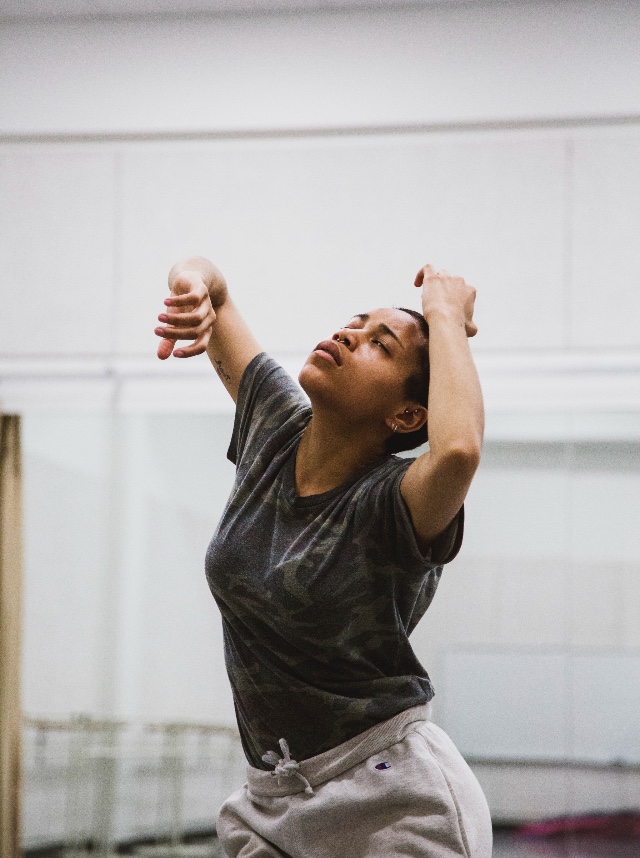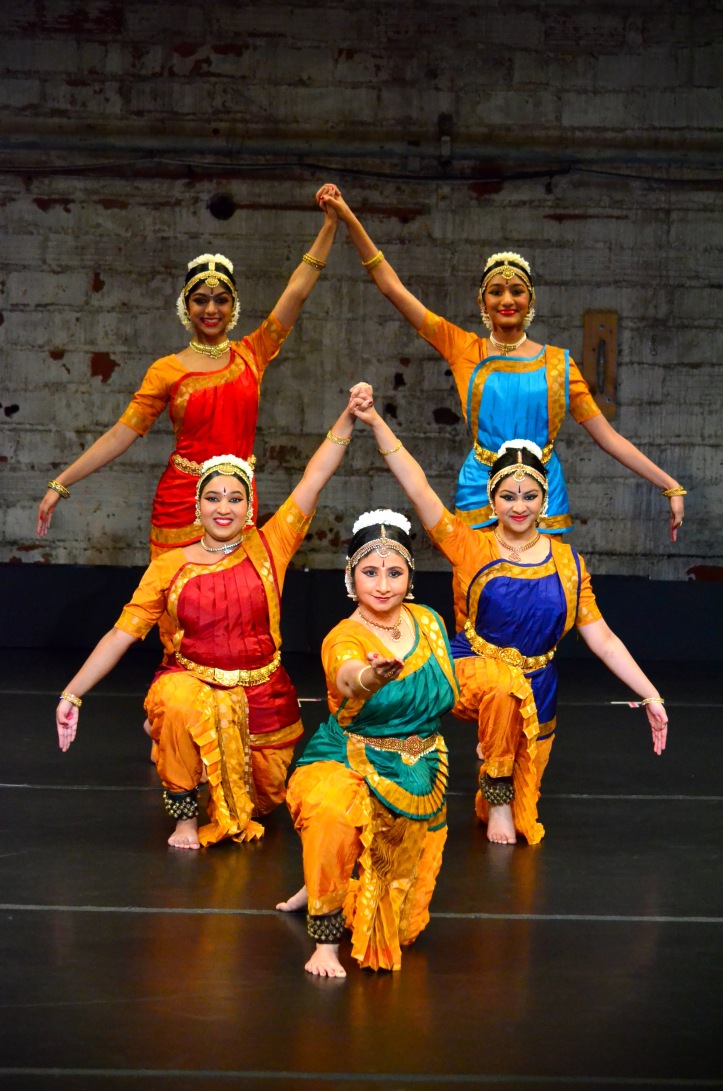On Saturday we watched the final performances of Cleveland Public Theatre’s DanceWorks 2019. Two companies shared the program, Terre Dance Collective and Shri Kalaa Mandir.
Terre Dance Collective bills itself as a group of movement artists but we think of it as the brainchild of Robert Rubama, something that he started in Washington D.C. and brought with him when he moved to Cleveland to dance with GroundWorks DanceTheater. Choreography for Saturday’s offering, Blood Orange, is credited to Rubama in collaboration with the dancers, Chelsi Knight, Emily Liptow, Akane Little, and Shannon Metelko.

Blood Orange uses eclectic music, much of it apparently layered over itself in a way that rendered it unpredictable. We recognized bits of Claude Debussy, Erik Satie, and Philip Glass. The dancing was similarly layered and unpredictable. Solos segued into duets into solos. The dancers interacted with each other but seldom danced in unison prior to the quartet at the very end.
(Gender studies and ambiguous gender identity seemed to figure prominently in dancer bios, costuming, and choreography. Accordingly, we’ll use 3rd person plural pronouns.)
Music and dance combine in a duet that we saw as a climax of timing and intensity at about midway through Blood Orange. One of the dancers articulates their fingers as they reach up; the other dancer quiets the first. This happens repeatedly until the two roll downstage with their heads close together. (See photo.)

Throughout Blood Orange, the choreography makes few demands on the technical abilities of the dancers even though, judging from the dancers’ bios, those abilities may be considerable. As we understand it, Blood Orange seeks to “expose the pure essence” of the dancers rather than to trade in technical display. And truly, not every dance needs to be about jumping high or doing many turns.
Learn more about Terre Dance Collective on their website. (https://terredance.wordpress.com/)
Shri Kalaa Mandir Center for Indian Performing Arts (SKM) performed an original piece – Vivarta / Transformations – choreographed by Sujatha Srinivasan. Given our limited knowledge of Bharathanatyam, the form of Indian classical dance taught and performed by SKM, we were unprepared for the many multicultural, secular, and contemporary aspects of Vivarta.
We had always thought of Bharathanatyam depicting ancient tales of Hindu gods, but Vivarta depicts a situation ripped from today’s headlines, “humankind’s irresponsible use of natural resources and the pollution of the land, water and air,” in the context of a grand retelling of the history of the universe from “the Great Big Bang” to a hopeful future in which people are transformed to “mindful and responsible inhabitants of the Earth.” In the program notes for Vivarta, SKM reaches out to general audiences by quoting from Abraham Lincoln and Genesis as well as the Atharvana Veda.

Moment by moment, Vivarta presented much the visual spectacle we expected from Indian classical dance. The costumes, credited to Aahaaryaa Tailors, were brightly colored with traditional tunics in vivid greens, blues, and reds over bright gold shirts, skirts, and leggings. The dancers were made up with vivid eyes and lips and their facial expressions were even more vivid and surprisingly varied. Mother Earth’s expression varied from beneficent to distressed to adamant. The ensemble’s faces were serene as they jumped and pranced as the elements, alert and innocent as they depicted animals. The 4 dancers who assailed Mother Earth with slashing movements maintained stylized facial expressions that seemed cruel and inexorable as they drove the other dancers away and threw Mother Earth to the floor. “What have you done to me?” asked Mother Earth in a taped voice-over.

Perhaps a factual narrative would have ended there with the earth and humanity in a state of irreversible degradation. That’s the slippery slope we’re sliding down now, right? But Vivarta ends by presenting a hopeful turn of events in which Mother Earth vents her fury in hurricanes and droughts and the people come to their senses. The stage lighting by Wes Calkin flashes red and Mother Earth dances until her 4 assailants lie prostrate in submission. (Vic was glad the theater was dark, for he became somewhat emotional at this point in Vivarta. If only reality could take such a turn.)

Vivarta is danced to recorded music by 4 prominent Carnatic musicians based in India. Lalgudi G. J. R. Krishnan and Lalgudi Vijayalakshmi are brother and sister violinists in a musical dynasty. M. S. Sukhi and T. M. Krishna are easy to find on Amazon and Spotify.
Shri Kalaa Mandir Center for Indian Performing Arts (SKM) gives classes in and around Strongsville and Solon. They perform frequently in the Cleveland area. Learn more on their Facebook page (https://www.facebook.com/skmDance/).
We watched Terre Dance Collective and Shri Kalaa Mandir at Cleveland Public Theatre on Saturday 6/15/2019.
Elsa Johnson and Victor Lucas
[…] use of facial expressions when we watched them perform at Cleveland Public Theater recently. (https://clevelandconcertdance.com/2019/06/20/cpts-danceworks-wraps-up/) We’re not valuing one dance form over another. We’re simply describing two different ways of […]
LikeLike
[…] 3 groups of 4 dancers performed. We recognized many of them from their recent performance at (https://clevelandconcertdance.com/2019/06/20/cpts-danceworks-wraps-up/) Cleveland Public […]
LikeLike